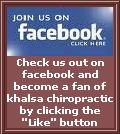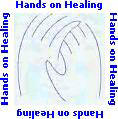

| Home | Dr. Mha Atma's Health Newsletter | Ideas for Good Health | Patient of the
week |
| >About |
| >Meet The Doctor |
| >Meet The Team |
| >Testimonials |
| >Hall of Fame |
| >Upcoming Schedules |
| >Contact Us |
| >New Patient Forms |
| >Exercises |
| >Links To Better Health |
| >Videos |
| >What is Chiropractic? |
| >Why go to Chiropractor? |
The Spinal Column
SPRING 2015
Dear Patients and Friends,
Our bodies were made to move. We evolved as humans over millions of years of constant movement. For eons we spent nearly all our time walking and running in search of food and shelter. But in just the last few centuries, and much more so in the last few decades, most of us come to spend most of our lives without much movement—sitting in cars, at computers, in front of TV’s and elsewhere. Sitting for long periods of time reduces circulation, makes our brains and bodies more sluggish, and compresses our spines. Our spinal discs, the cartilage shock absorber pads between our vertebrae, have few or no blood vessels and depend on constant spinal movement to pump fluids and nutrients to their cells. Without much movement they may degenerate faster. Recent studies have shown that folks who sit most of the day have higher death rates, even if they spend regular exercise time. What to do?
We can set a strong intention to introduce movement into our spines and our bodies. Here are some ways:
1. Breathing deeply expands our lungs and rib cage and moves the spine with every breath. Practicing full abdominal breathing and developing the habit of frequently taking slow deep breaths releases stress, improves spinal function, and improves oxygen flow to every part of us.
2. Some folks who sit much of the day at work get standing desks, which improves circulation and reduces the negative effects of sitting. Some even create a treadmill desk, where they can walk while they work at a computer and while they talk on the phone. Getting up out of your chair every 15 to 20 minutes, even for a few seconds, to reach something that you purposefully put out of reach or just to stretch can greatly reduce the harmful effects of prolonged sitting. Some people sit on a large exercise ball or a round springy backless balance chair, which introduces constant slight spinal movement while sitting. You can also do simple stretching and movement exercises for a minute or two at a time while you are in your chair. See your chiropractor (that’s me!) for specific suggestions.
3. Exercise, of course, is vital to restoring and maintaining the good health of your spine, your entire body and your brain. Ten to 15 minutes of stretching and movement exercise every day and 30 to 60 minutes of walking or other aerobic exercise most days is required. But even 5 or 10 minutes is better than none!
4. To maintain a healthy and pain-free spine, you must keep all the spinal bones moving. The above three steps are essential, but periods of inactivity along with various daily life strains and stresses inevitably cause some spinal joints to become stiff enough that they lose their ability to move and you begin to compensate around them, even during exercise. Loss of movement causes the disc between the two restricted vertebrae to suffer from lack of circulation. At that point, the only way to restore normal spinal movement is a chiropractic adjustment. So periodic chiropractic maintenance adjustments, ranging from once weekly to once every three months depending on your needs, is extremely helpful in maintaining a healthy mobile spine.
Yours for better health, naturally,
Mha Atma S. Khalsa, D.C.
Chiropractic may boost strength, muscle function, and prevent fatigue —New research into the effects of chiropractic care suggests that it may have an important role to play in maximizing sporting performance and aiding recovery from a range of conditions where muscle function has been compromised. The New Zealand College of Chiropractic’s Centre for Chiropractic Research has recently published a study in the journal Experiment Brain Research1 which demonstrates that after a full spine chiropractic adjustment session there was an increase in the subjects’ ability to contract one of their leg muscles. The study shows an increase in muscle electrical activity readings of almost 60%, and a 16% increase in absolute force measures. There was also a 45% increase in the ‘drive’ from the brain to the muscle. Dr Heidi Haavik, chiropractor and Director of Research at the NZCC says: “The results of the study…indicate that spinal adjustments can prevent fatigue, so we recommend chiropractic care to be a part of medical treatment for patients that have lost tonus of their muscles or are recovering from muscle degrading dysfunction such as with stroke or orthopaedic operations….These results may also be of interest to sports performers and we have recommended a similar study be conducted in a sports population.”1 Experimental Brain Research. In press. DOI: 10.1007/s00221-014-4193-5 URL link: http://link.springer.com/article/10.1007/s00221-014-4193-5
Mediterranean Diet Linked to Slower Aging, Less Disease —A new study found that people eating a Mediterranean-style diet had longer chromosome telomeres--suggesting that they have a lower risk of disease and death. Harvard Medical School researchers studied 4,676 women as part of the ongoing Nurses' Health Study. Researchers measured telomere length in white blood cells from drawn blood. The women completed dietary questionnaires and were given a score of 0 to 9, with higher numbers indicating greater consistency in following the diet. Each single point change in adherence to the Mediterranean diet correleted with 1.5 years of telomore aging, so a 2-point difference would correspond to a three-year difference in faster or slower aging, and a nine-point difference would correspond to a 13.5 year difference in faster or slower aging. The Mediterranean diet consists of a large intake of vegetables, fruits, legumes, nuts, unrefined grains, fish and olive oil, as well as a moderate intake of wine and a low intake of dairy products, saturated fats, and refined grains and sugar. British Medical Journal, 2014;349.g6676
Chiropractic Treatment Shown to Reduce Back Pain and Increase Disc Space —One of the traits of low back pain involves the loss of intervertebral disc height. The disc is the cartilage pad between the bony vertebrae that acts as a shock absorber for the spine. As we age, our discs have a tendency to get thinner which can cause a myriad of other problems. A recent study found that chiropractic care (manual manipulation) can not only reduce low back pain, but also increase disc height. Patients were treated three times weekly for six weeks with either “manual therapy” or a spinal decompression machine. While both groups exhibited significant improvement in lower back pain, only the manual therapy group also demonstrated an increase in disc heights. Researchers concluded that “Manual therapy using joint mobilization techniques and flexion-distraction techniques is considered an effective intervention for addressing low back pain and disc heights in patients with chronic low back pain.”
J Phys Ther Sci. 2014 Aug;26(8):1259-62. doi: 10.1589/jpts.26.1259. Epub 2014 Aug 30.
Pregnant Women Get Back Pain Relief with Chiropractic —Researchers recruited 115 pregnant women who were experiencing pain in their back or pelvic region and not engaged in chiropractic care during the previous three months. Each woman then was given chiropractic care, with the frequency of visits and methods of manipulation solely determined based on the preference of the chiropractor. After one week of treatment, 52 percent of subjects reported improvement, increasing to 70 percent after one month, 85 percent after three months and 90 percent after six months. 88 percent reported continued positive effects one year after the initial chiropractic treatment session. Chiropractic and Manual Therapies 2014;22(1):15.
http://blog.toyourhealth.com/wrblog/2015/03/risks-of-nsaids-you-should-know/
Risks of NSAIDs You Should Know
Nonsteroidal anti-inflammatory drugs (NSAIDs) include over-the-counter drugs like Ibuprofen (Motrin, Advil) and aspirin. A paper published in The American Journal of Accountable Care noted the frequent and serious complications that are all too typical for those who regularly use these drugs:
·
“A systematic review of 17 prospective observational studies found that 11% of preventable drug-related hospital admissions could be attributed to NSAIDs.”·
“Studies have documented that the risk of adverse events associated with NSAIDs are both dose-dependent and duration dependent”·
Myocardial infarction (MI), stroke, kidney problems, and gastrointestinal (GI) bleeding as some of the serious potential side effects·
“Some estimates suggest that each year more than 100,000 patients are hospitalized for NSAID-related GI complications alone”·
“NSAID use has been associated with increased risk for hospitalization due to MI as well as for heart failure (HF).”·
“Likewise, acute renal failure, which is also associated with NSAID use, can ultimately lead to expensive dialysis treatment.”Just because a drug is sold without a prescription, doesn’t mean it doesn’t have serious side effects.
http://blog.toyourhealth.com/wrblog/2015/03/low-back-pain-vitamin-d/
Low Back Pain & Vitamin D
A study entitled “Relationship between vitamin D deficiency and chronic low back pain in postmenopausal women” looked at how chronic low back pain may associated with vitamin D deficiency. Researchers found that for older women, “Vitamin D deficiency was significantly more common in patients suffering from chronic LBP than in controls.”
If you or someone you know suffers from chronic low back pain, ask your doctor of chiropractic to see if you are getting sufficient vitamin D.
http://blog.toyourhealth.com/wrblog/2015/03/infant-antibiotics-childhood-obesity/
Infant Antibiotics = Childhood Obesity
A recent study looks at “the impact of antibiotics prescribed in infancy (ages 0-23 months) on obesity in early childhood (ages 24-59 months).” The findings of the study (also reported in the Los Angeles Times) are that “early exposure to broad-spectrum antibiotics was also associated with obesity” and that “cumulative exposure to antibiotics was associated with later obesity.”
All drugs have side effects. Antibiotics should only be considered when absolutely necessary
 THANKS
FOR HELPING US HELP OTHERS!
THANKS
FOR HELPING US HELP OTHERS!

Nearly all our patients first come to our office through the recommendations of our present and past patients. We appreciate each of you who take the time and energy to help another person experience the benefits of chiropractic. We couldn't do it without you!
Our thanks to:
|
|
 MY CHIROPRACTIC
STORY
MY CHIROPRACTIC
STORY 
EMILY KEITH
I was having intense soreness and throbbing on the right side of my neck. It would often cause headaches. It had been going on for a month and it would sometimes affect my vision, especially while I was using my computer at work. I tried some exercises and getting neck massages, but that would only help temporarily. I was taking Advil for the pain, which would help but also only temporarily.I was referred to Khalsa Chiropractic by my primary physician after I explained that other treatments were not fully helping. I used to be a dancer and would often feel pain in my lower back. Chiropractic treatment had helped me then, so I knew it would help this time.My first impression when coming here was that his office felt very Zen and centered on healthy healing. I felt that right way with Dr. Mha Atma. He recommended sticking to a treatment plan of twice weekly adjustments (later once weekly) and doing daily exercises. Thus far (after two months), everything has been great and the time we have put into our treatment has really helped. I feel much better now.I have already referred one friend to Dr. Mha Atma and she has started treatment. I see now, firsthand, how truly beneficial chiropractic care is and the results of taking good care of your body. This has been a great overall experience and I look forward to my continued care with Dr. Mha Atma .
-------------
http://lifecarechiropractic.com/blog/aspirin-protect-heart/
Aspirin to Prevent Heart Disease; Are You STILL Taking It?
by James Bogash, D.C.
Everyone’s doin’ it. TV ads say you should be doin’ it. Your doctor says you should be doin’ it. But should you really take aspirin for your heart?
For a very long time, this answer was a strong, positive “YES.” After all-aspirin thins the blood so it would make sense for aspirin to lower your risk of a heart attack, right?
Yes, and hormone replacement therapy for women was a great idea as well. At least until someone decided to really look at this multi-billion dollar drug industry and found that HRT actually caused everything you were told it would help. Oops.
So for decades, doctors and advertising messages bombarded you with the idea that aspirin will protect your heart. The problem is that this was largely a theory that was promoted to you as fact. But, over a decade ago (2001 to be exact), studies were published finding no benefit to taking aspirin in low-risk individuals. That means that, for the average person, he or she was taking a drug well-known to lead to bleeding ulcers, kidney damage, strokes, macular degeneration and even pancreatic cancer, all with the idea that it was good for his or her heart.
It took another decade for further studies to make it to the limelight, but in 2010 another study was published and again found no benefit to using aspirin to protect the heart. Two large meta-analysis of multiple studies published in 2011 also found no benefit to using aspirin to prevent a first heart attack (primary prevention).
At this point, I was SURE that this was the death of aspirin to prevent a first heart attack (the data is a little stronger if you’ve already had a heart attack), but I still have patients taking aspirin for their heart. And they seemed shocked to hear that it really has no benefits (ok…if you treat 1000 patients with aspirin for 5 years, 2.9 less people with have a heart attack, although 2.8 will experience a major bleed due to the aspirin. Net gain of 1 person out of 10,000 patients. So I guess I can’t say that there is NO benefit to aspirin..).
Just in case you still aren’t convinced, this particular study should put your confusion to rest. In it, researchers looked at 22,576 patients who were at least 50 years of age with stable heart disease that required high blood pressure medications. These patients were grouped into an “ischemic” group if they had a history of unstable angina, myocardial infarction, transient ischemic attack, or stroke while all others were grouped as “non-ischemic.” Here’s what they found:
· 56.7% of all participants used aspirin, which increased to 69.3% by the end of the study.
· In the “non-ischemic” group aspirin actually INCREASED the risk of a heart attack, stroke or dying by 11%.
· However, in the “ischemic” group aspirin did lower the risk of a heart attack, stroke or death by 13%.
For those of us who have NOT had a heart attack, this is NOT good news. Given the previous studies on aspirin over the past 14 years or so, the results of this study are no surprised at all.
What I will suggest is what I have suggested to all my patients–relying on a single drug (with side effects) to try to change your risk of heart attack instead of making wise lifestyle choices is just plain stupid. And yet sadly, this is what society promotes.
---------------------------------------------------------------------------------
GOOD HEALTH IS A JOURNEY.
STAY ON COURSE WITH REGULAR CHIROPRACTIC CARE.
PLANT THE SEEDS OF GOOD HEALTH:
SEE YOUR CHIROPRACTOR REGULARLY!

